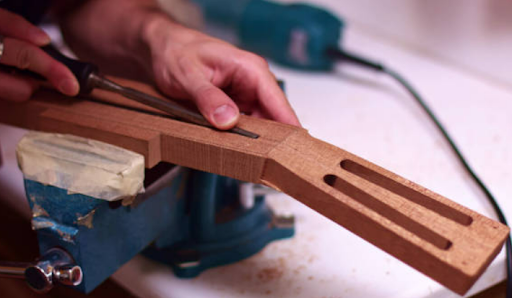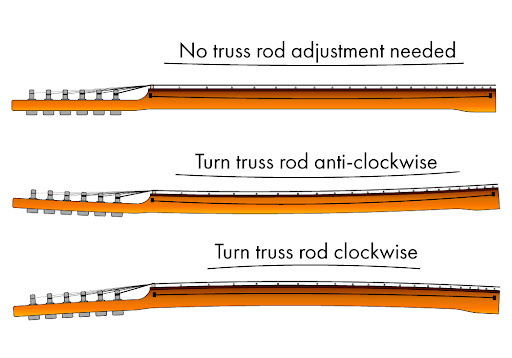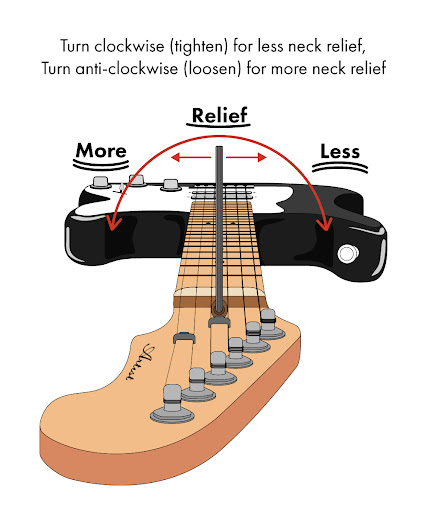How to Adjust your Truss Rod
Author: Lachlan Bush Date Posted:13 November 2020
What's a Truss Rod?

A Truss Rod is a long metal rod that runs the length of the guitar neck, underneath your fretboard. It anchors at each end so that when you tighten or loosen the nut on one end it will straighten or bow the neck of the guitar in order to counteract the tension of the strings. You can use your truss rod to get your neck almost straight, leaving slight relief, then you can start to consider your action ie. the height of the string from the fretboard.
Before you consider making any truss rod adjustments, you must have fresh strings, stretched and tuned to pitch.

You may need to make occasional adjustments to your guitar to straighten your neck. Being made from natural materials, it is normal for guitars to adjust slightly to humidity and temperature, and the wood will also age and flex over time. The bone of the nut can be affected by weather changes, and using alternate tunings will affect the tension on the neck. Additionally, if you switch from a light-gauge to a heavy-gauge string, there will be more tension pulling on the neck, which will bow it slightly. Conversely, switching from heavy to light-gauge strings will have the opposite effect, releasing tension and allowing the neck to bend backward.
As such, you may need to adjust your instrument every 6-12 months. Most brand-new guitars will need one good adjustment once they have settled, and any further adjustments in future will probably be much smaller.
If you find that your action is too high, or some frets are buzzing the first thing to do is check how straight your neck is, and make adjustments to your Truss Rod if necessary. Once your neck relief is correctly aligned you can tweak the bridge or saddle height to fine-tune your action. This is a quick 5 - 10 minute process and is easy when you follow this simple guide.

How do I adjust my Truss Rod?
- Tune your guitar
- Hold down the first and last fret
- Look at the 8th fret. Is there any gap?
Yes- Tighten the truss rod in small increments until the string is almost touching.
No- Loosen the truss rod slightly so that the smallest of gaps appears.
Careful! Only move the truss rod in small increments and give it time to settle! It can take some time for the fibres of the wood to react to the change in tension, after an adjustment leave the neck to sit for up to an hour. Go slowly or you may cause damage. - Once you're happy with the amount of distance between the string and the 8th fret, tune the guitar again.
- Repeat steps 3 and 4.
- Enjoy your perfectly aligned neck!
Remember: you will need to turn the tool until you engage and feel tension on the truss rod nut, before this point the nut will feel loose and won’t make any difference to the neck. If you then reverse and go the other way, you will need to engage the nut in the opposite direction before it has any effect – you should feel zero tension on your allen key, and you’ll notice more tension when the nut is re-engaged.
What size tool do I need to adjust my Truss Rod?
You will receive a new truss rod adjustment tool with every Artist guitar, and we also include the allen keys required for both saddle and locking nut adjustments.
The allen keys for Artist Guitars truss rods are 4mm in diameter and are a standard allen shape. This is a common size for many guitars, however, this may vary for other brands (in particular, Gibson, Maton, and Fender, which all differ very slightly).
Remember, guitars are made from natural materials and may need minor adjustments on occasion, this is normal, and exactly why we include truss rods in their construction – don’t be afraid to have a go, just reach out to us if you need assistance!
- If your action is too high or too low, check your neck relief
- Make adjustments to the neck relief using a truss rod adjustment tool, following the steps above
- Only adjust your truss rod with fresh strings that have been stretched and tuned up to pitch
- Only adjust your truss rod in small increments. Leave time for the wood to settle, tune the instrument, and check your relief between each adjustment
- Truss Rod adjustment tools are usually 4mm in diameter, but this varies with some manufacturers.
- Artist Guitars and Martin both use a 3/16” / 4mm (approx.) truss rod nut
- Gibson uses a 5/16” / 8mm (approx.) truss rod nut
- Fender uses a ⅛” / 3.12mm (approx.) truss rod nut
- Maton uses their own unique tool that doesn’t follow standard allen measurements
Thanks for reading this blog! to give you even more great content, check out our pages.
- Join our newsletter for tips, advice, new products, and great deals
- Visit our YouTube channel for some great Demo’s & Tutorials
- Our Facebook page for updates and specials and more
- Visit our website
I hope this article has helped. if you need any assistance please email:
sales@artistguitars.com.au or call us on 1300 489 816
© Artist Guitars 2023

